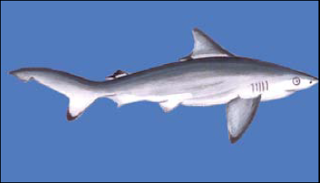Despite being in a comparatively inaccessible habitat, many endemic fish species in India are at the verge of extinction. According to the latest IUCN red data list, there are more than a dozen species of organisms under the Chondrichthyes class of fishes in India which are classified as endangered. Among this, five of them are considered
No records of this species are available from India during the last two decades, with the last known spotting taking place in 1979. However, it is still considered as critically endangered and even possibly extinct from the face of the earth. This rare and little known fish species takes it name from Pondicherry, a union territory in South India.
 |
The Pondicherry Shark (Carcharhinus hemiodon)
|
According
MoEF documents, this marine fish was reported inshore on continental and insular shelves. As per earlier records, the fish was once widely distributed in Indian Ocean – from Gulf of Oman to Pakistan and India. Though there are no records of the species near the shores of Sri Lanka, it is expected that this rare fish will be present here also. The Pondicherry shark has been once reported from the mouth of the Hooghly River also.
Like the case of many fish species, Pondicherry shark also is a victim of indiscriminate commercial fishing in inshore aquatic habitats. The population of this fish is almost completely depleted to an extent that it is no more reported even as a by-catch from the areas around its natural habitat.
The Ganges Shark (Glyphis gangeticus)
The Ganges Shark got its name from its mother river Ganges where it was found in plenty numbers once. Though not much is known about the nature and character of this shark, it is known that it has adaptations which help it lead the life of a fish eating shark.
 |
The Ganges Shark (Glyphis gangeticus)
|
Its unique body adaptations include the small eyes which help it to survive in turbid waters and slender teeth which help it to have a fish diet. Mature individuals are recorded to grow up to a length of 2.04 meters.
Actually found in the turbid waters of river Ganges and Bay of Bengal, the fish has been reported from Hooghly river mouth region also. There are speculations that the fish can be present in Pakistan also.
Ganges shark is also a victim of indiscriminate shark hunting fisheries. Construction of dams and barrages in Ganges and the alarmingly rising pollution of the habitat have also contributed to a drastic population fall of these fishes.
Though there have been not a single instances of finding a live specimen of the species in recent times, a few jaws of the species were spotted in the international market suggesting that the species is not completely extinct.
Long-comb Saw fish or Narrow-snout Sawfish (Pristis zijsron)
 |
Long-comb Saw fish (Pristis zijsron)
|
Usually
found in shallow water, Long-comb Sawfish can grow up to 4.3m in
length. The reports of these species varies considerably from 40 metres
belwo the sea surface to the muddy bottoms of inland estuaries.
Distributed
in the Indo-Pacific region including Australia, Cambodia, China, India,
Indonesia and Malaysia, this fish is also a victim of indiscriminate
fishing and aquarium trade.
The Knife-tooth Sawfish (Anoxypristis cuspidata)
 |
| The Knife-tooth Sawfish (Anoxypristis cuspidata) |
Resembling sharks in its body structure, the Knife-tooth Sawfish has a long narrow snout with blade-like teeth. This fish can grow up to 2.8 meters.
With its ability to survive in a range of salinity conditions, it is found in shallow coastal waters as well near the bottom of the sea even up to a depth of 40 meters. This ability has given it a widespread distribution in the western part of the Indo-Pacific region, including Red Sea.
Their unique feature – the long saw with teeth on it, make them easily caught even in primitive fish nets. Since their meat, fins and saw are highly valued, they end up in the international trade rackets, even if caught as a by-catch by fishermen.
Large-tooth Sawfish (Pristis microdon)
 |
Large-tooth Sawfish (Pristis microdon)
|
Found in the western part of the Indo-Pacific in countries like East Africa to New Guinea, Philippines and Vietnam to Australia, Large-tooth saw fish is unique with its heavy-body and short, massive saw. Mature indivduals have been recorede to grow to a maximum of 3 meters in length. Usually a bycatch with Bull Sharks and the Green Sawfish, Large –tooth Sawfish is reported from inland waters of Mahandi River even up to 64 km off the coast. According ot MoEF documents, it is common in the estuaries of the Ganga and Brahmaputra, but its present records are rare.
While dam construction and pollution from industries and other sources has destroyed its habitat considerably, indiscriminate aquarium tarde is also threatening the existence of this fish.






No comments:
Post a Comment
Please feel free to have your say on our stories. Comments will be moderated. anonymous Comments will not be approved. No links in the comment body unless meant for sharing a very relevant info.